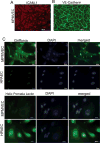Method for the Culture of Mouse Pulmonary Microvascular Endothelial Cells
- PMID: 29658013
- PMCID: PMC5898805
Method for the Culture of Mouse Pulmonary Microvascular Endothelial Cells
Abstract
Pulmonary microvascular endothelial cells (ECs) are integral to the alveoli-capillary barrier of the lung. The EC barrier integrity is known to be disrupted in severe lung diseases such as acute respiratory distress syndrome (ARDS), pneumonia and pulmonary edema. Mice are commonly used to model these diseases, dictating an increasingly high demand for murine ECs isolation and culture. Despite the significant number of protocols for the culture of various types of murine cells, the isolation of microvascular endothelial cells remains a challenging procedure. In our manuscript we developed adetailed step-by-step refined method for isolation murine pulmonary microvascular ECs for in vitro studies. We separated cells using platelet endothelial cell adhesion molecule antibody and characterized ECs with antibodies against intercellular adhesion molecule-1, acetylated-low density lipoprotein, and vascular endothelial (VE)-cadherin. Further, we confirmed microvascular origin of these cells using Griffonia simplicifolia and Helix pomatia (negative control) staining. Barrier properties of EC monolayer were characterized by conducting electric cell-substrate impedance sensing experiments with the edemagenic agents, lipopolysaccharide and nocodazole, and known barrier-protective agents, adenosine and sphingosine-1-phosphate. The described complete protocol provided consistent and reproducible results.
Keywords: Cell culture; Lung; Method; Microvascular endothelial cells; Murine pulmonary endothelial cells.
Conflict of interest statement
Disclosure/Duality of Interest No author has any disclosure or duality of interest for any product or result in this manuscript.
Figures







Similar articles
-
Vascular endothelial cadherin expression in lung specimens of patients with sepsis-induced acute respiratory distress syndrome and endothelial cell cultures.Pathobiology. 2013;80(5):245-51. doi: 10.1159/000347062. Epub 2013 Apr 27. Pathobiology. 2013. PMID: 23635392
-
Honokiol protects pulmonary microvascular endothelial barrier against lipopolysaccharide-induced ARDS partially via the Sirt3/AMPK signaling axis.Life Sci. 2018 Oct 1;210:86-95. doi: 10.1016/j.lfs.2018.08.064. Epub 2018 Aug 29. Life Sci. 2018. PMID: 30171880
-
Isolation and culture of pulmonary endothelial cells from neonatal mice.J Vis Exp. 2010 Dec 14;(46):2316. doi: 10.3791/2316. J Vis Exp. 2010. PMID: 21178973 Free PMC article.
-
In vitro analysis of human periodontal microvascular endothelial cells.J Periodontol. 2014 Aug;85(8):1135-42. doi: 10.1902/jop.2013.130209. Epub 2013 Nov 28. J Periodontol. 2014. PMID: 24283655
-
Prolyl Hydroxylase Domain-2 Protein Regulates Lipopolysaccharide-Induced Vascular Inflammation.Am J Pathol. 2019 Jan;189(1):200-213. doi: 10.1016/j.ajpath.2018.09.012. Epub 2018 Oct 17. Am J Pathol. 2019. PMID: 30339838 Free PMC article.
Cited by
-
Elevated Cytokine Levels in Plasma of Patients with SARS-CoV-2 Do Not Contribute to Pulmonary Microvascular Endothelial Permeability.Microbiol Spectr. 2022 Feb 23;10(1):e0167121. doi: 10.1128/spectrum.01671-21. Epub 2022 Feb 16. Microbiol Spectr. 2022. PMID: 35171047 Free PMC article.
-
Exercise during pregnancy mitigates the adverse effects of maternal obesity on adult male offspring vascular function and alters one-carbon metabolism.Physiol Rep. 2020 Sep;8(18):e14582. doi: 10.14814/phy2.14582. Physiol Rep. 2020. PMID: 32975908 Free PMC article.
-
Isolation of intimal endothelial cells from the human thoracic aorta: Study protocol.Med J Islam Repub Iran. 2019 Jun 4;33:51. doi: 10.34171/mjiri.33.51. eCollection 2019. Med J Islam Repub Iran. 2019. PMID: 31456975 Free PMC article.
-
Oxymatrine Modulation of TLR3 Signaling: A Dual-Action Mechanism for H9N2 Avian Influenza Virus Defense and Immune Regulation.Molecules. 2024 Apr 24;29(9):1945. doi: 10.3390/molecules29091945. Molecules. 2024. PMID: 38731436 Free PMC article.
-
Glucosamine-Mediated Hexosamine Biosynthesis Pathway Activation Uses ATF4 to Promote "Exercise-Like" Angiogenesis and Perfusion Recovery in PAD.Circulation. 2024 Nov 19;150(21):1702-1719. doi: 10.1161/CIRCULATIONAHA.124.069580. Epub 2024 Sep 10. Circulation. 2024. PMID: 39253813
References
-
- Akis N, Madaio MP. Isolation, culture, and characterization of endothelial cells from mouse glomeruli. Kidney Int. 2004;65:2223–2227. - PubMed
-
- Wu Z, Hofman FM, Zlokovic BV. A simple method for isolation and characterization of mouse brain microvascular endothelial cells. J Neurosci Methods. 2003;130:53–63. - PubMed
-
- Marelli-Berg FM, Peek E, Lidington EA, et al. Isolation of endothelial cells from murine tissue. J Immunol Methods. 2000;244:205–215. - PubMed
Grants and funding
LinkOut - more resources
Full Text Sources
Other Literature Sources
